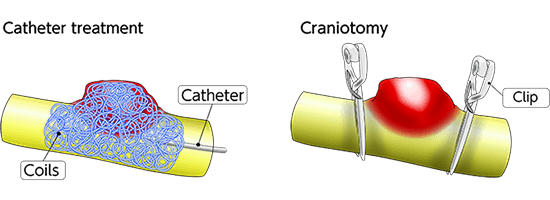- HOME
- For Patients
- Artery dissection
- Treatment of artery dissection
Artery dissection
- About of artery dissection
- Cause of artery dissection
- Symptom of artery dissection
- Diagnosis of artery dissection
- Treatment of artery dissection
Treatment of artery dissection
Cerebral artery dissection may recover by itself over several months. Surgery is carried out if a subarachnoid hemorrhage occurs or if a dissecting cerebral aneurysm continues to grow in size.
Headache
Treated by managing blood pressure and resting. Because the risk of subarachnoid hemorrhage is particularly high within 2 weeks of onset, particular care is taken during this time. The condition of the cerebral artery dissection is monitored by MRA. If it improves, no further treatment is needed, but if hypertension is present, then treatment for this is continued. If the bulge in the cerebral artery dissection (dissecting cerebral aneurysm) gets larger, surgery may be carried out to prevent a subarachnoid hemorrhage.
Cerebral infarction
A drip infusion is administered to improve the circulation, and blood pressure management is implemented. If the blood vessel is narrow and there is a risk that the cerebral infarction may worsen, antiplatelet drugs may be used to stop the blood from clotting.
Subarachnoid hemorrhage
Surgery is carried out to close the blood vessel. It may be performed from inside the blood vessel using a catheter, or by a craniotomy (cutting open the skull). In either case, the dissected part of the blood vessel is closed off to prevent it from rupturing again. Because the walls of the blood vessel at the dissection site are weak, merely treating it like a normal cerebral aneurysm and closing off the bulge while leaving the blood vessel in place is not sufficient to prevent it from rupturing again.
Unruptured dissecting cerebral aneurysm that has grown larger
This is treated in the same way as a subarachnoid hemorrhage. Recently, however, treatment using stents to block the bulging part with a coil while leaving the blood vessel in place has also come into use.








